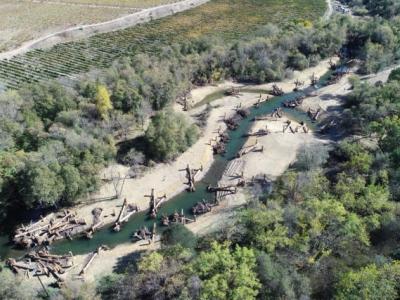Integrating Flood Management, Steelhead, Beaver and Wildlife Habitat Restoration in the Napa River Watershed
Tour Coordinators:
Ann Riley, San Francisco Regional Water Quality Control Board
Leslie Ferguson, San Francisco Regional Water Quality Control Board
Tour Leaders:
Rick Thomasser, Napa County Flood Control and Water Conservation District
Jorgen Blomberg, ESA
Kate Lundquist, Occidental Arts and Ecology Center
Brock Dolman, Occidental Arts and Ecology Center
Kevin Swift, Swift Water Design
Margie Caisley, CDFW
This field tour will tour two types of restoration projects: 1) an environmentally sensitive flood management and habitat restoration project located in an urban setting (downtown Napa); and 2) further upstream in agricultural areas, large-scale stream and riparian habitat restoration projects being implemented along the Napa River. The flood control and habitat restoration project along Napa Creek in downtown Napa demonstrates the feasibility of implementing an environmentally sensitive flood management project in a highly urbanized area including the feasibility of using LWD and willow mattress to stabilize banks, removal of infrastructure (parking lots/ bridges and rerouting roads), and creek daylighting to create channel and inset floodplain habitat for steelhead and other wildlife. We also note that following project construction, beavers have colonized the project site, increasing ecologic diversity and providing an opportunity to develop and implement co-existence strategies in Napa Creek and nearby downtown Tulocay Creek. The Napa Creek project was approved by the Army Corps of Engineers to provide protection for the 100-year flood, and this project demonstrates that biotechnical and wildlife sensitive flood control projects can be safely constructed in highly urbanized area.
The second part of the tour showcases 15 miles of habitat restoration occurring further upstream in the Napa Valley in two agricultural reaches along the Napa River: Rutherford and Oakville to Oak Knoll. The goals of these projects are to enhance channel habitat complexity and floodplain connectivity as needed to improve the quality of aquatic and riparian habitat, and reduce sediment delivery associated with channel incision and accelerated rates of bank erosion rates, which also satisfies the requirements of the Napa River sediment TMDL.
Vineyard properties along the Napa River have voluntarily removed vines and relocated flood berms and roads to provide additional room for a more functional river corridor. Restoration techniques include the establishment of inset floodplain and secondary channel features, bank stabilization using biotechnical methods, enhancement of the riparian corridor, instream habitat structures, wetland creation and native plant revegetation. This tour will feature 2 stops: The first location in Rutherford will demonstrate site evolution where the work occurred over 5 years ago and vegetation has re-established and geomorphic features have evolved. The second stop will feature a large, newly constructed site featuring approximately 6 acres of riparian restoration and 7.7 acres of created wetlands, biotechnical streambank stabilization, and instream/floodplain habitat restoration including live wood structures, boulder clusters and grade control riffles. Beaver have been active in both restoration sites. These projects demonstrate that while the river ecosystem will not be restored to its natural state, with the cooperation of local landowners, significant improvements in river geomorphology, riparian, wildlife and aquatic ecology (steelhead, chinook, lamprey, assemblage of native fish and beaver) can occur.









